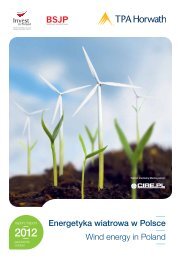Energetyka wiatrowa w Polsce Wind energy in Poland - TPA Horwath
Energetyka wiatrowa w Polsce Wind energy in Poland - TPA Horwath
Energetyka wiatrowa w Polsce Wind energy in Poland - TPA Horwath
Create successful ePaper yourself
Turn your PDF publications into a flip-book with our unique Google optimized e-Paper software.
7<br />
7.1<br />
7.2<br />
66<br />
Wybrane kwestie podatkowe Selected Tax Aspects<br />
Podatek od nieruchomości<br />
Property tax<br />
W obecnym stanie prawnym, pomimo wcześniej<br />
istniejących wątpliwości, opodatkowaniu podatkiem<br />
od nieruchomości podlegają wyłącznie<br />
części budowlane turbozespołów, czyli fundament<br />
z pierścieniem oraz wieża. Zarówno organy<br />
podatkowe, jak i sądy adm<strong>in</strong>istracyjne są zgodne<br />
w tym zakresie. We wrześniu ubiegłego roku<br />
Trybunał Konstytucyjny wprost stwierdził 33 , że<br />
opodatkowaniem podatkiem od nieruchomości<br />
podlegają jedynie budowle objęte def<strong>in</strong>icją zawartą<br />
w ustawie z dnia 7 lipca 1994 r. - Prawo budowlane,<br />
a wykładnia rozszerzająca jest niedopuszczalna.<br />
Tym samym wątpliwości dotyczące zakresu opodatkowania<br />
podatkiem od nieruchomości zostały<br />
ostatecznie rozwiane.<br />
Z badań autorów raportu wynika, iż pomimo w miarę<br />
jednorodnego podejścia zarówno władz podatkowych,<br />
jak i <strong>in</strong>westorów do opodatkowania podatkiem<br />
od nieruchomości jedynie części budowlanych<br />
turbozespołu, w praktyce dochodzi do znacznych<br />
różnic wartościowych w opodatkowaniu farm<br />
podatkiem od nieruchomości. Wynikają one głównie<br />
z różnic technologicznych w zakresie konstrukcji<br />
i montażu wieży. W większości przypadków<br />
wartość budowlana turbozespołu (fundament<br />
z wieżą) nie przekracza 20% wartości <strong>in</strong>westycji<br />
ogółem, niemniej w przypadku wież budowanych<br />
z materiałów nowej generacji, wyposażonych<br />
w nowoczesne elementy konstrukcyjno-użytkowe<br />
(np. w<strong>in</strong>da), udział wartości części budowlanych<br />
w całości może osiągać znacznie wyższe wartości.<br />
Amortyzacja elektrowni wiatrowych<br />
<strong>W<strong>in</strong>d</strong> farm depreciation<br />
Wydatki poniesione na turb<strong>in</strong>y wiatrowe podlegają<br />
zaliczeniu do kosztów podatkowych poprzez<br />
odpisy amortyzacyjne. Mimo iż aktualny kształt<br />
przepisów podatkowych nie nastręcza istotnych<br />
wątpliwości, w praktyce organów skarbowych<br />
mnożą się <strong>in</strong>terpretacje dotyczące stawek, jakie<br />
należy zastosować dla amortyzacji siłowni wiatrowych.<br />
Przedmiotem częstych sporów jest, czy<br />
dla celów amortyzacji turb<strong>in</strong>ę wiatrową traktować<br />
należy jako całość, czy też dokonać jej podziału na<br />
część budowlaną i niebudowlaną i do wydzielonych<br />
części zastosować przypisane im stawki amortyzacyjne.<br />
Podział tego rodzaju nie znajduje podstawy<br />
33 Zob. Wyrok Trybunału Konstytucyjnego z dnia 13 września 2011 r.<br />
sygn. akt. P 33/09<br />
<strong>Energetyka</strong> <strong>wiatrowa</strong> w <strong>Polsce</strong> / <strong>W<strong>in</strong>d</strong> <strong>energy</strong> <strong>in</strong> <strong>Poland</strong><br />
With<strong>in</strong> the exist<strong>in</strong>g legal framework, despite previously<br />
exist<strong>in</strong>g uncerta<strong>in</strong>ty, property tax is charged<br />
exclusively on structural portions of turb<strong>in</strong>e sets,<br />
i.e. the foundation with the r<strong>in</strong>g and the tower. The<br />
position of both tax authorities and adm<strong>in</strong>istrative<br />
courts is unanimous <strong>in</strong> that regard. In September<br />
2011 the Constitutional Tribunal stated explicitly 33 that<br />
property tax shall only be charged on constructions<br />
<strong>in</strong>cluded <strong>in</strong> the def<strong>in</strong>ition stipulated <strong>in</strong> the Construction<br />
Law of 7 July 1994, and that an extensive<br />
<strong>in</strong>terpretation is <strong>in</strong>admissible. Thus, any doubts<br />
regard<strong>in</strong>g the scope of property tax assessment were<br />
ultimately dispelled.<br />
Research conducted by the authors of the report<br />
<strong>in</strong>dicates that despite the relatively uniform position<br />
of both tax authorities and <strong>in</strong>vestors regard<strong>in</strong>g<br />
the property tax assessment on the structural<br />
components<br />
of the turb<strong>in</strong>e set only, <strong>in</strong> practice the values of<br />
property taxes assessed <strong>in</strong> respect of w<strong>in</strong>d farms<br />
differ substantially. The differences arise primarily<br />
from technological differences concern<strong>in</strong>g the tower<br />
construction and assembly. In most cases, the<br />
structural value of the turb<strong>in</strong>e set (foundation and<br />
tower) does not exceed 20% of the total <strong>in</strong>vestment<br />
value; however, <strong>in</strong> the case of towers that are built<br />
us<strong>in</strong>g the latest materials, equipped with modern<br />
structural and utility components (e.g. an elevator),<br />
the share of structural components’ value <strong>in</strong> the total<br />
value of the <strong>in</strong>vestment may be much higher.<br />
Expenditure <strong>in</strong>curred <strong>in</strong> relation to w<strong>in</strong>d turb<strong>in</strong>es is<br />
tax deductible <strong>in</strong> the form of depreciation write-offs.<br />
Even though the current form of tax regulations does<br />
not give rise to any material doubts, <strong>in</strong> practice tax<br />
authorities offer multiple <strong>in</strong>terpretations with regard<br />
to the rates applicable to w<strong>in</strong>d farm depreciation. It is<br />
often disputable whether, for depreciation purposes,<br />
a w<strong>in</strong>d turb<strong>in</strong>e should be treated as a whole or it<br />
should be divided <strong>in</strong>to a structural and non-structural<br />
portion, with respective write-off rates applicable to<br />
the separated portions. This k<strong>in</strong>d of a separation has<br />
no legal grounds, and is an expression of the tax<br />
authorities’ unauthorized application of the concept<br />
33 See: judgment of the Constitutional Tribunal of 13 September 2011,<br />
file ref. P 33/09



